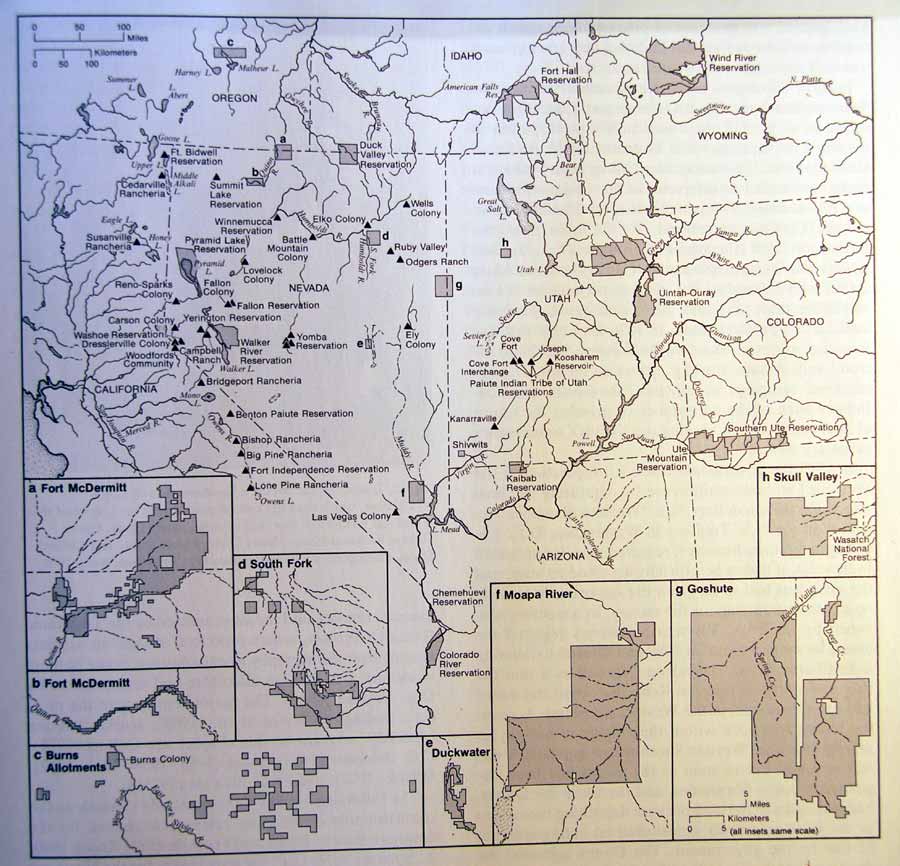 |
Shoshone Aboriginal Lands and Reservations
 |
Time Line:
1. Treaty of Ruby Valley in 1863 . Approved by all the bands of the Western Shoshone, the treaty acknowledged title to their aboriginal lands throughout what would become northern and central Nevada, and federal recognition as sovereign Tribes. Although the treaty permitted establishment of mines and ranches, as well as homesteads, roads, rail lines, timber industries and towns to support the mining industry, such establishment did not extinguish aboriginal title from the Shoshone. Also see Wikipedia Article
2. Executive Orders establish individual Reservations, as for example, in 1877 Duck Valley on the Idaho/Nevada border, of some 290,000 acres, or as late as 1940 the Ruby Valley of some 1,400 acres.
3. During the 1930s and 1940s Congress purchases abandoned homesteads and ranches, places them under trust status for the Indian communities.
4. During the 1960s and 1970s the Federal Government, through the Indian Claims Commission, attempts to compensate Tribes for aboriginal lands wrongly taken and treaty obligations reneged upon by the United States.
5. Western Shoshones asked to submit a claim, but only three groups - Duck Valley, Elko, South Fork - participate, later forming the Te-Moak Bands Tribal Council. This Council, elected from the three groups and representing only 30 percent all all the Western Shoshones, became the duly certified body representing all Western Shoshones in the claims process.
6. But most Western Shoshones boycotted the Claims proceedings, and did not want monetary compensation for lost lands. They felt as if the Government was trying to pay them off, rather than return aboriginal lands.
7. In 1974 the Shoshones at Battle Mountain formed the Western Shoshone Legal Defense and Educational Association, replaced in 1976 by the Western Shoshone Sacred Lands Association, to challenge the Federal Government and education the public. The Association sought to reopen the case and pursue land return rather than monetary compensation. The Claims Commission refused to reopen the case and only offered monetary compensation.
8. The Bureau of Land Management brought trespass suit against Carrie and Mary Dann, who refused to pay grazing permits on Shoshone land, and not on public domain.
9. The United States Congress had attempted to settle the claim in 1979, appropriating $26 million to purchase title to 24 million acres of tribal lands. The funds would be deposited in a "Western Shoshone Account," in the U.S. Treasury by Congress (from one government account to another). The enabling legislation did, however, require it to be formally accepted by the Shoshones, by a vote, before the distribution of the funds.
10. In 1980 the Western Shoshones rejected the award by a majority vote.
11. Nevertheless, the Western Shoshone Claims Distribution Act of 2004 (SB 958), introduced by Harry Reid and John Ensign, effectively transfers 26 million acres from the Western Shoshone to the United States Federal Government for $145 million (increased from the original $26 million) in cash distributions to the roughly 8,000 Shoshone tribe members, approximately $5 an acre, or $30,000 per tribal member. The Claims funds were transferred to the Western Shoshone Account, over the opposition of the 1980 vote and again in 2004, when seven of the nine tribal councils within the Western Shoshone Nation passed resolutions opposing the legislation.
12. KEY: The Federal Courts have ruled, in earlier cases, all the way up to the Supreme Court in 1985, that when the compensation is "awarded," the Shoshones would have not further claims to their aboriginal lands, and the Dann sisters must pay the grazing fees and incurred penalties. The transfer was made in 2004.
13. On March 10, 2006 the United Nations Committee on the Elimination of Racial Discrimination stated "credible information alleging that the Western Shoshone indigenous people are being denied their traditional rights to land."